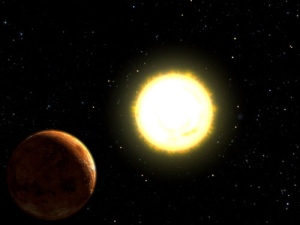 Artist concept of a Neptune-sized planet
Artist concept of a Neptune-sized planet
orbiting the star 55 Cancri. Credit: NASAAnother milestone has been reached in the two-decade old search for "extrasolar planets," a.k.a exoplanets-- planets that orbit stars other than our Sun. In November it was announced that the leading exoplanet research team-- the California and Carnegie Planet Search Team, led on the California side by U. C. Berkeley’s Dr. Geoff Marcy-- has succeeded in detecting five, count 'em, five planets orbiting the same parent star.
The star, 55 Cancri, a Sun-like star in the constellation Cancer, has been under exoplanet surveillance for 20 years, and yielded the secret of its first planet in 1996. Over the years of continued observations, one by one more planets in its retinue have been coaxed out of the data.
Personally, moments like this are an impetus to step back and reflect on the state of our understanding of the universe. How much more we know now than we did when I was a starry-eyed child back in the 1960s! We knew of no planets beyond our Solar System when I was a kid. In fact, further observation of our own Solar System has, ironically, reduced the number of planets at home from nine to eight! Even pictures of places like Mars, and certainly the moons of outer solar system planets like Jupiter and Saturn, were blurry, grainy images lacking much detail.
Now, more than 260 planets orbiting other stars have been found (although we don't have actual pictures of them at this point). Still, going from my childhood, when exoplanets were theoretical and the question was still asked whether our Solar System is somehow special, even unique, to have planets at all, to today's solid body count of "worlds out there"...is simply breathtaking.
Most exoplanet detections are made by the measurement of the slight wobbling motion a star makes due to the gravitational pull of any planets it might possess. You might be imagining astronomers taking video of a star and playing it back at high speed to see it slither like a snake-- but that isn't how it's done. Instead, the measurement is made using the Doppler Shift-- observing changes in the star's speed by measuring the corresponding change in the wavelength of its light. (This is the same way that the Highway Patrol nabs speeders on the freeway, using radio-frequency waves.)
